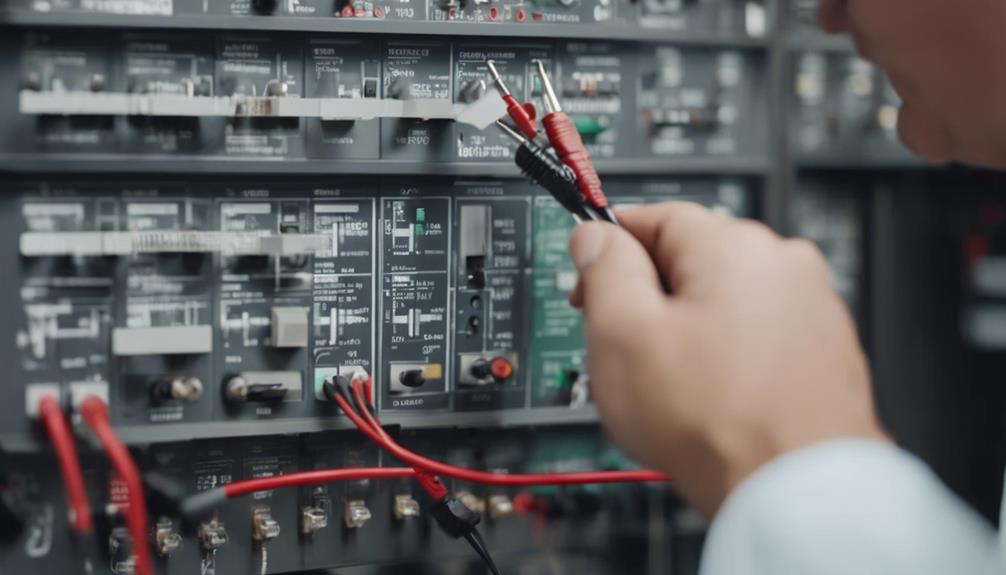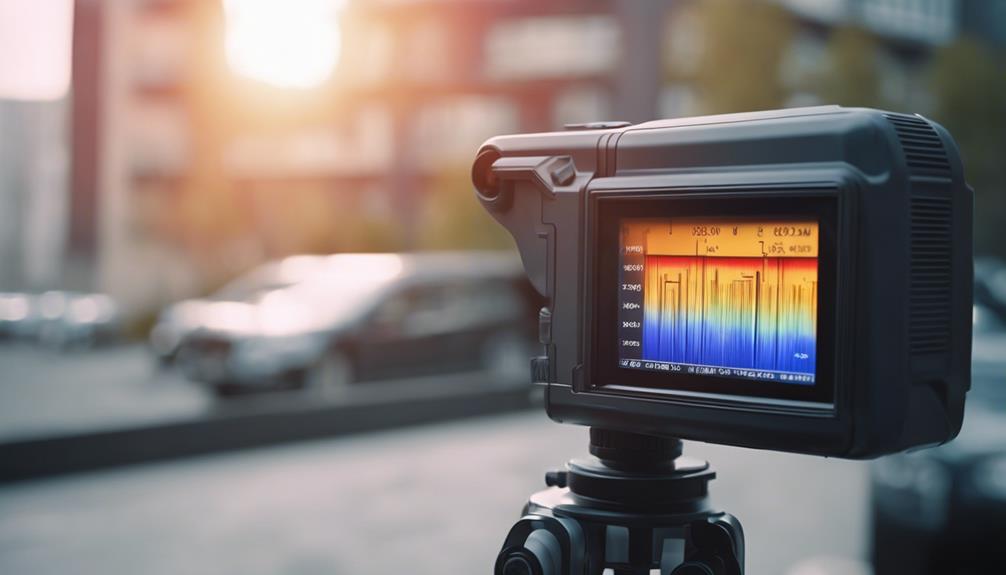Enhance your building checks with these seven superb tools. Inspection software helps make your reports easy and lets you take pictures.
Drones can help you see hard-to-reach places clearly.
Thermal imaging cameras can find hidden problems.
Moisture meters measure how damp a building is, helping to keep it strong.
Electrical testers can find issues with electricity flow.
It's important to wear safety gear like glasses, gloves, masks, and hard hats.
Also, tools to detect gas and carbon monoxide are crucial for thorough checks.
Each tool helps you get better at building inspections.
There's much more to learn if you keep exploring.
Key Takeaways
- Inspection Software is a handy tool that makes building checks easier and quicker. You can customize your own reports and take photos.
- Drones are super useful for looking at areas that are hard to get to. They can take clear pictures and videos.
- Thermal Imaging Cameras are like detective gadgets. They can find hidden problems like gaps in insulation, water leaks, and areas where electricity is overheating.
- Moisture Meters and Electrical Testers are important tools. They help find issues related to dampness and check how well the electrical system is working.
- Special equipment like gas detectors, carbon monoxide detectors, and GFCI outlet testers keep everyone safe. They can spot potential dangers before they become big problems.
Utilizing Inspection Software
Did you know there's a super tool called inspection software that makes checking buildings easier? Think of it like a super-smart helper who records, organizes and manages all the details for you. It's time to start using it!
This software isn't just handy, it's also mobile. That means you can take your work anywhere you go, not just at your desk. You can even make your reports look the way you want them to. Plus, you can take pictures of anything and everything, and the software will keep them safe and organized.
But remember, using this software isn't as easy as getting an app on your phone. You need to be smart about it. You need to think about what you need, do some research, and find the one that's just right for you. The software should be easy to use and work well with you. You're not just looking for a tool, you're looking for a friend in the field.
Drones in Building Inspection
Let's talk about how drones, those cool flying gadgets, are changing the way we inspect buildings. They're not just for fun, they're an important tool that makes building checks easier, simpler, and safer.
Think about those hard-to-reach places like the roof or very tall buildings. With drones, you don't have to worry about climbing up ladders or balance on scaffolding. Instead, you control the drone from the ground and it takes super clear photos and videos for you. It's like having a flying camera that can go anywhere!
Now, let's add thermal imaging to the mix. This lets the drone see heat changes, find water leaks, and spot insulation problems. This means you can catch and fix issues before they become big headaches. It's like being a building doctor, stopping problems before they get worse!
Drones also make the whole process faster. They can do in minutes what might take hours the old way. This means you can finish your work quicker, but still do a great job.
In short, drones are making a big difference in how we inspect buildings. They help to make the task safer, quicker, and more effective. It's time to start using drones for your building checks!
Thermal Imaging Camera Applications

Thermal imaging cameras are super useful tools, especially during building checks. They're not just cool tech toys. These cameras help spot problems that can't be seen with the naked eye, making the checks more precise.
They work by spotting changes in temperature. This tells us where the building doesn't have enough insulation, if any electrical parts are getting too hot, if there's hidden water, and if the building is wasting energy.
Detecting Hidden Issues
Thermal imaging cameras are super cool tools that can help find hidden problems in buildings, like gaps in insulation, water leaks, and electrical issues. These powerful gadgets are perfect for building inspectors like you, and they're easy to use too! They let you see things that can't be seen with just your eyes.
These cameras work by taking pictures of heat. So, where there's a problem in a building, the temperature might be different, and the camera can spot that. This way, you can find and fix problems before they get big, and show your clients exactly what you've done.
Using thermal imaging cameras can make your job as a building inspector easier and better. You'll be part of a group that values accuracy, speed, and quality in their work. So, don't let hidden problems get in the way of doing your best job. Use thermal imaging cameras today!
Enhancing Inspection Accuracy
Thermal imaging cameras are a cool tool for building inspections! They help you see tiny changes in temperature. These changes can signal problems like gaps in insulation or water leaks. These issues are often hidden and can't be seen with just our eyes.
This technology uses differences in temperature to make visual images. These images give important information during inspections. They can help find problems like electrical hotspots or water coming in where it shouldn't be.
Using thermal imaging cameras is like having x-ray vision for buildings. It's a way to find problems without having to break anything open. This makes inspections easier, quicker, and better. Just think, you're not just looking at buildings; you're helping to keep them safe and sound!
Importance of Moisture Meters
Moisture meters are really important tools that help us find out if a building has too much moisture. Think of them as like super detectives for water problems! If we find and fix these issues early, we can save a lot of money and keep the building strong and safe.
This tool works by measuring how much moisture is in a material, like wood or concrete. It's really good at this job and can give us exact numbers. This helps us know exactly where the problems are and how big they are.
So, if you're inspecting a building, a moisture meter should be in your toolbox. It can help you do your job better and make sure the building is in top shape. Plus, it can keep the building safe by helping prevent mold, which can grow if there's too much moisture.
Here's a simple chart that shows how great moisture meters are:
| Good Things About Moisture Meters | How They Help in Checking Buildings |
|---|---|
| Finding too much moisture | Stops mold and keeps the building strong |
| Giving exact moisture numbers | Helps us know exactly where and how big the problem is |
| Helping do better inspections | Finds problem areas |
| Saving money | Finds problems early so they're cheaper to fix |
| Making buildings better and safer | Makes sure inspections are really thorough |
Role of Electrical Testers

Electrical testers are key tools for building inspectors, especially in newer buildings. They're like detective tools for electricity. AFCI/GFCI testers, for example, are great at discovering where electrical power is flowing. These testers are super reliable and give clear, accurate results.
Voltage/current indicators are another important tool. They can measure a wide variety of electrical currents. This is really helpful because as an inspector, you need to know exactly what type of current you're dealing with. These tools make sure there are no surprises.
There's also a handy tool called a combination voltage indicator/GFCI tester. This tool can do a bunch of different tests, which saves you loads of time and effort. These tools are more than just gadgets, they're like your teammates, helping you get your job done correctly.
Just like you wouldn't let your skills get dull, it's essential to take good care of your tools. Make sure your electrical testers are always in top shape, so they give you the best results. As an inspector, you can't risk getting wrong readings. So, remember, if you take care of your tools, they'll take care of you.
Safety Tools for Inspectors
When you're doing inspections, it's super important to have the right safety tools. Here are the top five: safety glasses, gloves, masks, first aid kits, and helmets.
Safety glasses are more than just cool. They protect your eyes from stuff that could hurt them, like flying bits of debris or dangerous chemicals. Gloves are another important piece of kit – they keep your hands safe from things that could harm them.
Masks aren't just for stopping coughs or sneezes. They make sure you only breathe in clean air, by filtering out bad particles or gases. This is really important in places where the air might be harmful to breathe.
First aid kits and helmets are also key. The first aid kit isn't just a box of band-aids. It's got everything you need to deal with injuries right away. Helmets protect your head from things that might fall on it.
Using Specialized Inspection Equipment

Safety gear is a must when inspecting buildings. But, you also need special tools like gas detectors, carbon monoxide detectors, and GFCI outlet testers. These tools help you do your job better and safer. They can find things you can't see or touch.
For example, a carbon monoxide detector is a super important tool. It can find this dangerous gas that you can't see or smell, making sure the building is safe for people. A GFCI outlet tester is another important tool. It checks the electrical outlets in the building to make sure they're safe. You can't skip on these tools.
A digital camera is also a helpful tool. It can take pictures of issues or dangers in the building. This gives you proof to show others what you found. And when you're doing your job, a mask and safety glasses aren't just extras. They're like your superheroes, keeping you safe from bad stuff and protecting you from getting hurt.
Conclusion
You now know the best tools for checking buildings. They include inspection software, drones, thermal imaging cameras, moisture meters, and electrical testers.
You also need safety gear and other special tools. But remember, owning these tools isn't enough. You need to know how to use them properly. This way, you can make sure your buildings are safe and well-built.
Now, it's your turn to do a great job with these tools.


